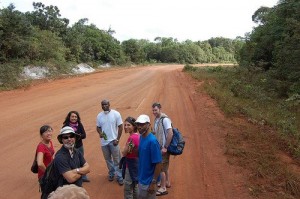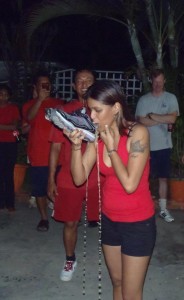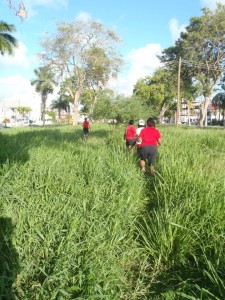It’s a mixture of athleticism and sociability, hedonism and hard work; a refreshing escape from the stress of daily life. It’s called hashing. Hashing is an exhilaratingly fun combination of running, orienteering and partying, where bands of hashers chase ‘hares’ on mile-long trails through town, country and bushy trails, all in search of exercise, camaraderie and good times.

The Hash House Harriers (abbreviated to HHH, H3, or referred to simply as hashing) is an international group of non-competitive running and social clubs. An event organized by a club is known as a ‘hash’ or ‘hash run’, with participants calling themselves ‘hashers’ or ‘hares’ and ‘hounds’.
Hashing began in Kuala Lumpur, Malaysia in 1938, when a group of British colonial officials and expatriates founded a running club called the ‘Hash House Harriers’. They named the group after their meeting place, the Selangor Club, nicknamed the ‘Hash House’. Hash House Harrier runs were patterned after the traditional British paper chase. In the paper chase a “hare” was given a head start to blaze a trail, marking his/her devious way with shreds of paper, all the while pursued by a shouting pack of “harriers”. Only the hare knew where he was going; the harriers followed his clues to stay on trail. Apart from the excitement of chasing the hare and solving the clues, reaching the end was its own reward, for there, thirsty harriers would find a tub of iced-down beverages and delicious food.
Hashing died out during World War II but picked up in the post-war years, spreading through the Far East, Australia, and New Zealand then exploding in popularity in the mid-70s. Today there are thousands of Hash House Harrier clubs in all parts of the world, with newsletters, directories, and even regional and world hashing conventions.
Hashing hasn’t strayed far from its Kuala Lumpur roots. A typical hash today is a loosely-organized group of 20 to 40 men and women who meet weekly or biweekly to chase the hare. They follow chalk, flour or paper, and the trails are never boring. They run streets and back alleyways, climb fences, explore drains, and blaze muddy trails in torrential rain. However, the trail’s end is a celebration and a party. When the hash officially ends, many members may continue socialising at an ‘on-after’, ‘on-down’, ‘on-on-on’, ‘après’, or ‘hash bash’, an event held at a nearby house, club, or restaurant.
In an interview with Guyana Times Sunday Magazine, Dr Colin Lee, a dental surgeon and grandmaster and dictator of The Georgetown (Guyana) Hash House Harriers, said this club was the first hash in Guyana, founded in 1989 by Dave ‘Jungle Man’ Taylor of the Kuala Lumpur Hash of Malaysia.
Dr Lee said the initial hash started off with just three persons but increased after it gained some popularity here. He stated that hash runs before had a maximum of 95 people on the run and a minimum of 5, and that the numbers vary.
In explaining a few features of a hash group in Guyana, Dr Lee said there’s the ‘hash cash’ the person who takes care of the money and records of the hash group; the ‘hash flash’ is the hash photographer and the only person who is allowed to use any technology during the hash; the ‘hash dray’ the person responsible for the drinks; and the ‘grandmattress’, (no typo here) the grandmaster’s wife.

Additionally, members are typically given a “hash name,” usually in deference to a particularly notorious escapade, a personality trait, or their physical appearance. In the Georgetown (Guyana) Hash House Harriers, after completing 11 runs, a hasher gets his hash name. Name suggestions are written in a book and voted on by the group. After 25 runs, a hasher gets the option of a name change, and remains the same for the rest of their hashing life.
There is also the special event: ‘Red Dress Run’, which is held annually. According to hasher lore, a newcomer in San Diego, U.S. was invited to a hash; she did not know it was a running group, and she attended the run in a red dress instead of running clothes. After being mocked for wearing such an outfit, she ran the trail anyway. Other hashers began wearing red dresses as a joke, and the tradition soon became an annual event that spread across the world. The point of the run is that all participants (of all genders) don red dresses of various sorts.
The traditional symbol of hashing is the outline of a human foot, often including the phrase “On-On”. T-shirts are a common symbol of various hash clubs, and events. A “down-down” is a means of punishing, rewarding, or merely recognizing an individual for any action or behaviour according to the customs or whims of the group. Generally, the individual in question is asked to consume without pause the contents of his or her drinking vessel, or risk pouring the remaining contents on his or her head. Individuals may be recognized for outstanding service, or for their status as a visitor or newcomer. Down-downs also serve as punishment for misdemeanours – real, imagined, or blatantly made up. Such transgressions may include: failing to stop at a drinking location, pointing with a finger, or the use of real names.
Dr Lee’s warning to new members: “Don’t wear new shoes.” Commonly, hashers who wear new shoes to a hash event are punished with drinking from that shoe.




